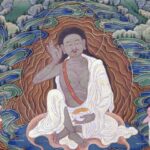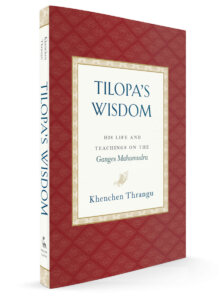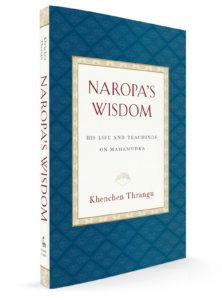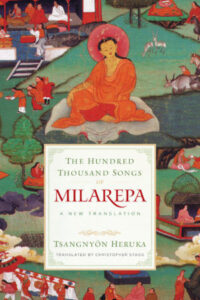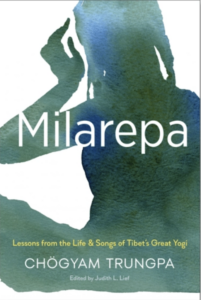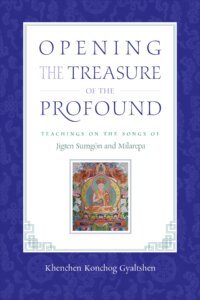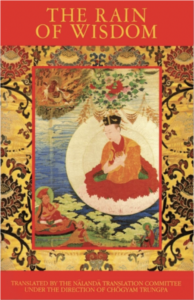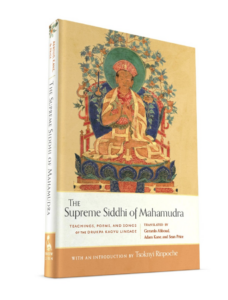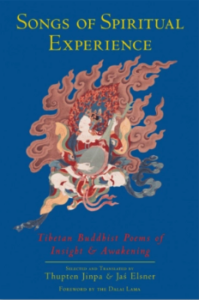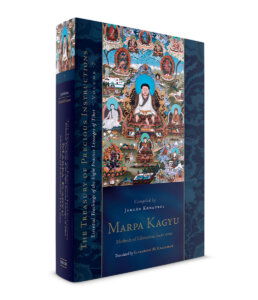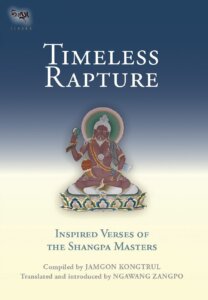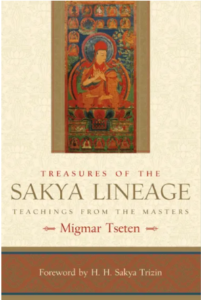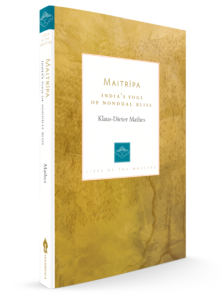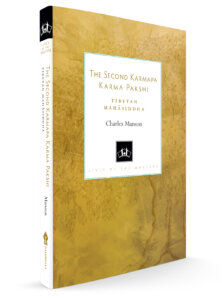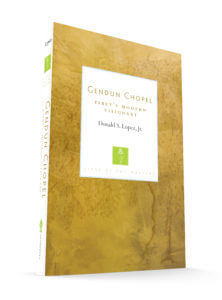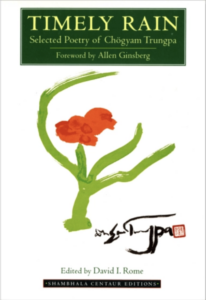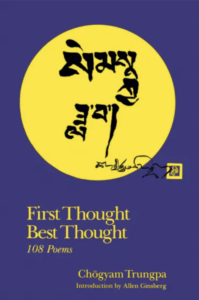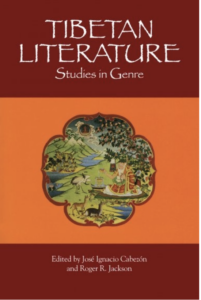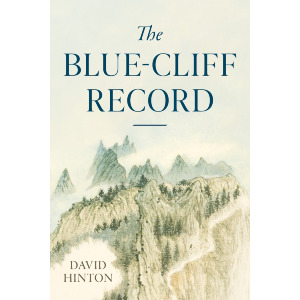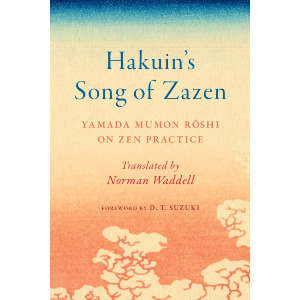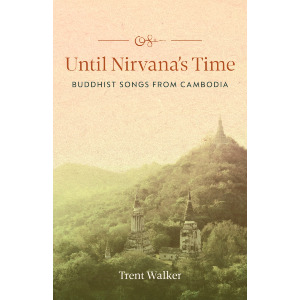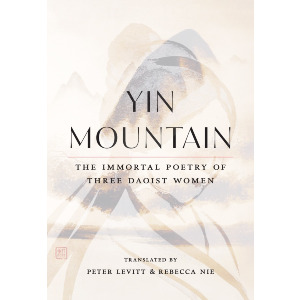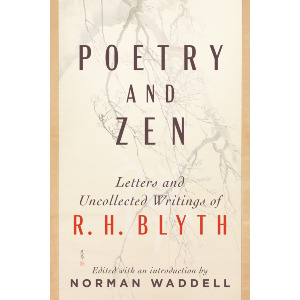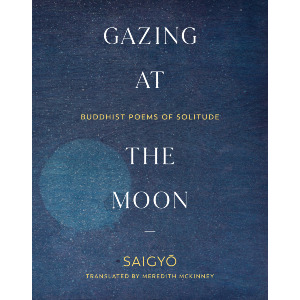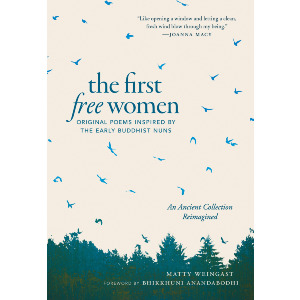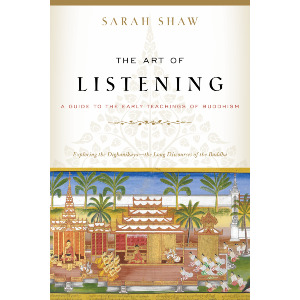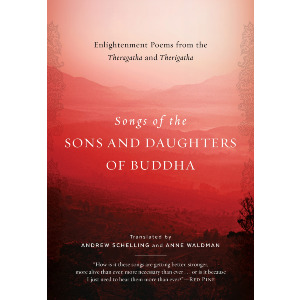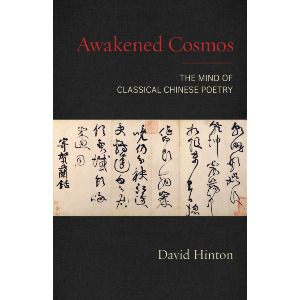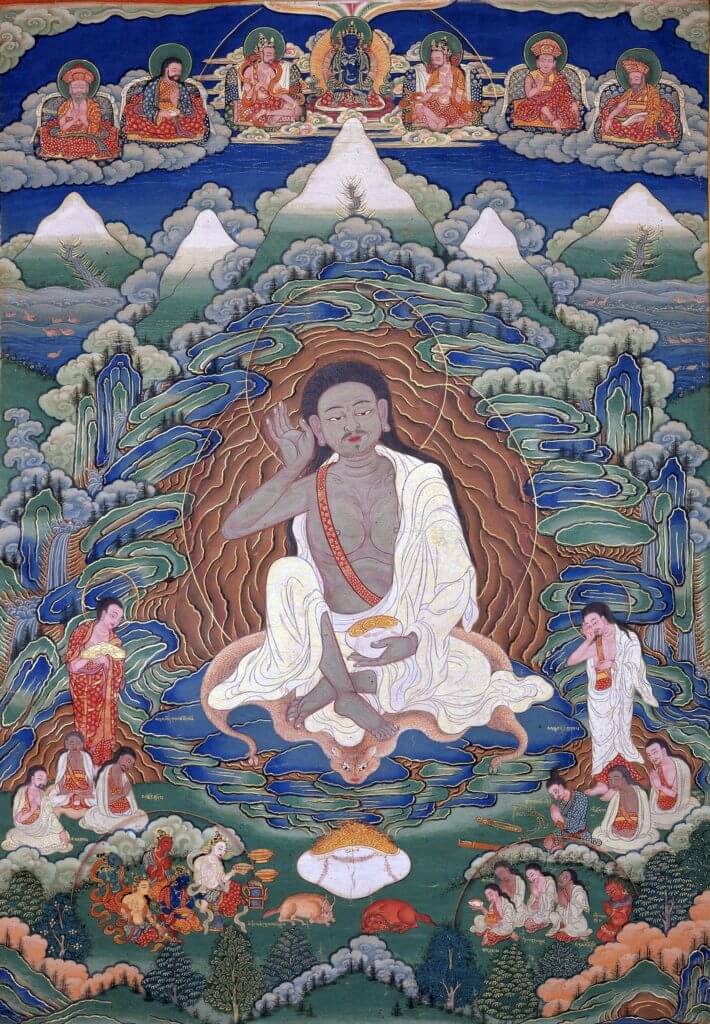
Doha and Gur
Doha (Sanskrit) or Nam Gur (Tibetan, Gur for short), is often translated as "Songs of Realization." This form of poetry is often sung or recited spontaneously and is characteristic of Vajrayana Buddhism. Dohas are often used as a means of transmitting wisdom and spiritual aphorisms, but also function as songs of praise and enjoyment especially in the context of ganachakra (tantric feast).
There are various forms of Doha with themes ranging from bliss and rapture to admonishing samsaric lifestyles to praising the lives of great masters. While a great number of Doha from both the Indian and Tibetan tradition are attributed to the Kagyu and Mahamudra tradition (as we'll see below), with the great sage, Milarepa, being the most widely known, Doha are found in all schools of Vajrayana Buddhism.
Our selection of books on Doha range from academic research-based explorations of the poetic genre to translations of traditional texts as well as biographical accounts of several famous Buddhist masters and writers of doha from our Lives of the Masters (LOM) series. Continue reading below or jump to a section of interest to explore this topic.
Songs of Realization in Mahamudra and the Kagyu Tradition
Tilo, Naro, Marpa, Mila: Doha and the Masters of Mahamudra
The Kagyu, or "Oral Lineage," school is one of the main schools of Tibetan Buddhism and can be traced back to the 10th India. There are several lines of lineage including the Shangpa Kagyu which traces it's lineage from the two dakini's Niguma and Sukhasiddhi as well as the Karma Kagyu, Drikung Kagyu, and Taklung Kagyu. The principle Kagyu lineage found today stems from the the spiritual lineage of Gampopa, which can be traced back to Tilopa, the 10th century Indian Mahasiddha.
Regarding Songs of Realization, or Doha, the Kagyu lineage is well known for transmitting spiritual teachings through these spontaneous songs. Among the masters of the Kagyu Mahamudra lineage, Milarepa is best known for his remarkable devotion and willingness to tread along the spiritual path despite difficult circumstances in addition to his style of teaching in spontaneous verse or doha. In fact, versified expressions of wisdom and pith instruction is common among Kagyu masters and is reflective of the spiritual prowess associated with Mahasiddhas (Great Spiritual Adepts) whose spiritual abilities gain them immediate access to the nature of reality and an ability to express wisdom teachings spontaneously and oftentimes outside of conventional means (for example, through song and dance).
The following books stem from the Kagyu tradition connected to Milarepa beginning with Tilopa (10th century) followed by his disciple Naropa (cira 1016–1100 CE), followed by Marpa (1012–1097), and finally, Milarepa (circa 1040-1123). Additional sources from other Kagyu linages are included below.
Tilopa's Wisdom: His Life and Teachings on the Ganges Mahamudra
Most traditions of Mahamudra meditation can be traced back to the mahasiddha Tilopa and his Ganges Mahamudra, a “song of realization” that he sang to his disciple Naropa on the banks of the Ganges River more than a thousand years ago. In this book, Khenchen Thrangu, a beloved Mahamudra teacher, tells the extraordinary story of Tilopa’s life and explains its profound lessons. He follows this story with a limpid and practical verse-by-verse commentary on the Ganges Mahamudra, explaining its precious instructions for realizing Mahamudra, the nature of one’s mind. Throughout, Thrangu Rinpoche speaks plainly and directly to Westerners eager to receive the essence of Mahamudra instructions from an accomplished teacher.
Naropa's Wisdom: His Life and Teachings on Mahamudra
As the disciple of Tilopa and the guru of Marpa the Translator, Naropa is one of the accomplished lineage holders of the Kagyu tradition of Tibetan Buddhism. He expressed his realization in the form of spiritual songs, pithy yet beautiful poems that he sung spontaneously. In this book, Khenchen Thrangu, a contemporary Karma Kagyu master, first tells the story of Naropa’s life and explains the lessons we can learn from it and then provides verse-by-verse commentary on two of his songs. Both songs contain precious instructions on Mahamudra, the direct experience of the nature of one's mind, which in this tradition is the primary means to realize ultimate reality and thus attain buddhahood. Read More
The Hundred Thousand Songs of Milarepa: A New Translation
Translated by Christopher Stagg
By Tsangnyon Heruka
By Milarepa
Powerful and deeply inspiring, there is no book more beloved by Tibetans than The Hundred Thousand Songs, and no figure more revered than Milarepa, the great eleventh-century poet and saint. An ordinary man who, through sheer force of effort, faith, and perseverance, overcame nearly insurmountable obstacles on the spiritual path to achieve enlightenment in a single lifetime, he stands as an exemplar of what it is to lead a spiritual life. Read More
Milarepa: Lessons from the Life and Songs of Tibet's Great Yogi
By Chogyam Trungpa
Edited by Judith L. Lief
He went from being the worst kind of malevolent sorcerer to a devoted and ascetic Buddhist practitioner to a completely enlightened being all in a single lifetime. The story of Milarepa (1040–1123) is a tale of such extreme and powerful transformation that it might be thought not to have much direct application to our own less dramatic lives—but Chögyam Trungpa shows otherwise. This collection of his teachings on the life and songs of the great Tibetan Buddhist poet-saint reveals how Milarepa’s difficulties can be a source of guidance and inspiration for anyone. His struggles, his awakening, and the teachings from his remarkable songs provide precious wisdom for all us practitioners and show what devoted and diligent practice can achieve.
Opening the Treasure of the Profound: Teachings on the Songs of Jigten Sumgon and Milarepa
By Khenchen Konchog Gyaltshen Rinpoche
By Milarepa
By Jigten Sumgon
Spiritual teachings in the form of songs—spontaneous expressions of deep wisdom and understanding that reveal the nature of reality—have been treasured since the dawn of Buddhism in India. In Opening the Treasure of the Profound, Khenchen Konchog Gyaltshen translates nine such songs, by Milarepa and Jigten Sumgön, and then explains them in contemporary terms. His insights take the Buddha’s ancient wisdom out of the realm of the intellectual and directly into our hearts. Here, we are invited into the world of transmission from master to disciple in order to discover truth for ourselves—to open the treasure of profound wisdom that fully realizes the nature of reality.
Collected Works
The Rain of Wisdom: The Essence of the Ocean of True Meaning
Translated by Nalanda Translation Committee
The art of composing spontaneous songs that express spiritual understanding has existed in Tibet for centuries. Over a hundred of these profound songs are found in this collection of the works of the great teachers of the Kagyü lineage, known as the Practice Lineage of Tibetan Buddhism.
Many readers are already familiar with the colorful life of the yogin Milarepa, an early figure in the Kagyü lineage, some of whose songs are included here. Songs by over thirty other Buddhist teachers are also presented, from those of Tilopa, the father of the lineage, to those of the Sixteenth Gyalwa Karmapa, as well as several songs by Chögyam Trungpa, the noted teacher of Buddhism in America who directed the translation of The Rain of Wisdom.
The diversity of the songs mirrors the richness of Tibetan Buddhism and gives us clear portraits of some of its most eminent teachers. Their longing for truth, their heartfelt devotion, and their sense of humor are all reflected. These poems share a beauty and intensity that have made them famous in Tibetan literature. With its vivid imagery and deep insight, The Rain of Wisdom communicates a profound and timeless understanding.
The Supreme Siddhi of Mahamudra: Teachings, Poems, and Songs of the Drukpa Kagyu Lineage
Translated by Sean Price
Translated by Adam Kane
Translated by Gerardo Abboud
Foreword by Tsoknyi Rinpoche
The Drukpa Kagyu lineage is renowned among the traditions of Vajrayana Buddhism for producing some of the greatest yogis from across the Himalayas. After spending many years in mountain retreats, these meditation masters displayed miraculous signs of spiritual accomplishment that have inspired generations of Buddhist practitioners. The teachings found here are sources of inspiration for any student wishing to genuinely connect with this tradition.
These translations include Mahamudra advice and songs of realization from major Tibetan Buddhist figures such as Gampopa, Tsangpa Gyare, Drukpa Kunleg, and Pema Karpo, as well as modern Drukpa masters such as Togden Shakya Shri and Adeu Rinpoche. This collection of direct pith instructions and meditation advice also includes an overview of the tradition by Tsoknyi Rinpoche.
Songs of Spiritual Experience: Tibetan Buddhist Poems of Insight and Awakening
Translated by Jas Elsner
Translated by Thupten Jinpa
Foreword by H.H. the Fourteenth Dalai Lama
The first major anthology of Tibetan spiritual poetry available in the West, Songs of Spiritual Experience offers original translations of fifty-two poems from all the traditions and schools of Tibetan Buddhism, spanning the eleventh to the twentieth centuries. These poems communicate spiritual insight with grace and precision, addressing the themes of impermanence, solitude, guru devotion, emptiness, mystic consciousness, and the path of awakening. Also included here is a thorough introduction exploring the characteristics of Tibetan verse and its role in Buddhism, and a glossary containing notes on the poems.
Marpa Kagyu, Vol. 1: Methods of Liberation
Essential Teachings of the Eight Practice Lineages of Tibet, Volume 7 (The Treasury of Precious Instructions)
By Jamgon Kongtrul Lodro Taye
Translated by Elizabeth M. Callahan
Although not specifically a book on doha, Marpa Kagyu, Volume 1 includes select texts from the Mahasiddha Saraha called Treasury of Dohās: Esoteric Instructions on Mahāmudrā and Doha for the People: Song That Is a Treasury of Dohās. Saraha, also known as Sarahapa or Sarahapdāda, was an 8th century Indian master and is known as the first Mahasiddha as well as one of the first founds of the Mahāmudrā tradition.
More about this volume:
The seventh volume of the series, Marpa Kagyu, is the first of four volumes that present a selection of core instructions from the Marpa Kagyu lineage of Tibetan Buddhism. This lineage is named for the eleventh-century Tibetan Marpa Chokyi Lodrö of Lhodrak who traveled to India to study the sutras and tantras with many scholar-siddhas, the foremost being Naropa and Maitripa. The first part of this volume contains source texts on mahamudra and the six dharmas by such famous masters as Saraha and Tilopa. The second part begins with a collection of sadhanas and abhisekas related to the Root Cakrasamvara Aural Transmissions, which are the means for maturing, or empowering, students. It is followed by the liberating instructions, first from the Rechung Aural Transmission. This section on instructions continues in the following three Marpa Kagyu volumes. Also included are lineage charts and detailed notes by translator Elizabeth M. Callahan. Read More
Timeless Rapture: Inspired Verse of the Shangpa Masters
By Jamgon Kongtrul Lodro Taye
Edited and translated by Ngawang Zangpo
Throughout history awakened ones have celebrated the rapture of mystical states with inspired verse sung extemporaneously. This book offers a rare glimpse into the mysticism of the Shangpa Kagyu lineage a tradition based mainly on the profound teaching of two women. This compendium of spontaneous verse sung by tantric Buddhist masters from the tenth century to the present includes translations as well as short descriptions of each poet's life and a historical overview of the lineage.
From the Sakya Lineage
Treasures of the Sakya Lineage: Teachings from the Masters
By Migmar Tseten
Foreword by H.H. Sakya Trizin
Though not specifically a book on Doha, Treasures of the Sakya Linage includes several Doha including The Great Song of Experience by Jetsun Dragpa Gyaltsten
More about this book:
Treasures of the Sakya Lineage is a rich collection of teachings by both contemporary and ancient Sakya masters, showing a thousand years of lineage continuity. It provides an overview of the history, view, key lineage figures, and crucial teachings of the oldest continuously operating institution among the four lineages of Tibetan Buddhism. Learn More
From the Lives of the Masters Series
Our Lives of the Masters Series (LOM) provide a much needed glimpse into the lives of some of the most creative thinkers in history. Each volume, as Kurtis Schaeffer, the series editor puts it, "tells the story of an innovator who embodied the ideals of Buddhism, crafted a dynamic living tradition during his or her lifetime, and bequeathed a vibrant legacy of knowledge and practice to future generations."
In terms of Songs of Realization, though not explicitly focused on Doha the following volumes from LOM include select translations of Dohas from three notable Indian and Tibetan masters.
Maitripa: India's Yogi of Nondual Bliss
Maitripa was a student of Naropa and prominent Indian Buddhist Mahasiddha known for his remarkable teachings on emptiness and non-duality. He composed numerous treatise in addition to a great number of Dohas. Maitripa includes A Treasure of Dohās and other verses such as The Ten Verses on True Reality.
More about this volume:
Maitripa (986–1063) is one of the greatest and most influential Indian yogis of Vajrayana Buddhism. The legacy of his thought and meditation instructions have had a profound impact on Buddhism in India and Tibet, and several important contemporary practice lineages continue to rely on his teachings.
Early in his life, Maitripa gained renown as a monk and scholar, but it was only after he left his monastery and wandered throughout India as a yogi that he had a direct experience of nonconceptual realization. Once Maitripa awakened to this nondual nature of reality, he was able to harmonize the scholastic teachings of Buddhist philosophy with esoteric meditation instructions. This is reflected in his writings that are renowned for evoking a meditative state in those who have trained appropriately. He eventually became the teacher of many well-known accomplished masters, including Padampa Sangyé and the translator Marpa, who brought his teachings to Tibet. Read More
The Second Karmapa Karma Pakshi: Tibetan Mahasiddha
Karma Pakshi was recognized as a as a reincarnation of the First Karmapa, Dusum Khyenpa at a young age and underwent extensive studies and practice. He authored several texts some of which have survived and is known for his systemization of the Kathok tradition. The Second Karmapa Karma Pakshi includes a number of his musings and reflections including Song for a Disciple and Deathbed Song.
More about this volume:
Karma Pakshi is considered influential in the development of the reincarnate lama tradition, a system that led to the lineage of the Dalai Lamas. Born in East Tibet in the thirteenth century, Karma Pakshi himself was the first master to be named Karmapa, a lineage that continues to modern times and has millions of admirers worldwide. During his lifetime, Karma Pakshi was widely acknowledged as a mahāsiddha—a great spiritual adept—and was therefore invited to the Mongol court at the apogee of its influence in Asia. He gave spiritual advice and meditation instructions to the emperor Möngke Khan, whom he advised to engage in social policies, to release prisoners, and to adopt a vegetarian diet. After Möngke’s death, Karma Pakshi was imprisoned by the successive emperor Kubilai Khan, and much of Karma Pakshi’s writing was done while he was captive in northeast China. He was eventually released and returned to Tibet, where he commissioned one of the medieval world’s largest metal statues: a seated Buddha sixty feet high.
Centuries later, two Buddhist meditation masters, the First Mingyur Rinpoche and Chögyam Trungpa Rinpoche, were inspired by Karma Pakshi to write meditation practices that are profoundly important to contemporary Tibetan Buddhist practitioners: respectively, the Karma Pakshi Guru Yoga and the Sādhana of Mahāmudrā. Read More
Gendun Chopel: Tibet's Modern Visionary
Gendun Chopel was a great scholar, poet, and artist known for his creative and unconventional thinking. Gendun Chopel includes a selection of poetry in addition to his writing about India and Tibet and his more controversial teachings from his Treatise on Passion.
More about this volume:
Visionary, artist, poet, iconoclast, philosopher, adventurer, master of the arts of love, tantric yogin, Buddhist saint. These are some of the terms that describe Tibet’s modern culture hero Gendun Chopel (1903–1951). The life and writings of this sage of the Himalayas mark a key turning point in Tibetan history, when twentieth-century modernity came crashing into Tibet from British India to the south and from Communist China to the east. For the first time, the astonishing breadth of his remarkable accomplishments is captured in a single, definitive volume.
Here is an exploration of Gendun Chopel’s life as a recognized tulku, or incarnation of a previous master, from becoming a monk and soon surpassing the knowledge of his teachers, to his travels and discoveries throughout Tibet, India, and Sri Lanka. His exposure to the wider world brought together his philosophical training, artistic virtuosity, and meditative experience, inspiring an incredible corpus of poetry, prose, and painting. While Gendun Chopel was known by the Tibetan establishment for his vast learning and progressive ideas—which eventually landed him in a Lhasa prison—he was little appreciated in his lifetime. But since his death in 1951, his legacy, fame, and relevance across the Tibetan cultural landscape and beyond have continued to grow. Read More
Modern Visionaries
The tradition of spontaneous instruction and Songs of Realization continues today through modern visionaries. Likewise, Tibetan poetry continues to gain interest among readers and practitioner alike as translations of these meaningful texts become available. The following are just a couple examples of modern Tibetan Buddhist songs and poetry.
Timely Rain: Selected Poetry of Chogyam Trungpa
By Chogyam Trungpa
Edited by David I. Rome
Foreword by Allen Ginsberg
Newly selected poetry from previously published and unpublished works, Timely Rain is the definitive edition of poems and sacred songs of the renowned Tibetan meditation master, Chogyam Trungpa Rinpoche.
First Thought Best Thought: 108 Poems
By Chogyam Trungpa
Introduction by Allen Ginsberg
Here is a unique contribution to the field of poetry: a new collection of works by America's foremost Buddhist meditation master, Chögyam Trungpa. These poems and songs—most of which were written since his arrival in the United States in 1970—combine a background in classical Tibetan poetry with Trungpa's intuitive insight into the spirit of America, a spirit that is powerfully evoked in his use of colloquial metaphor and contemporary imagery. Read More
Research on Tibetan Literature
Lastly, we are delighted to present this collection of essays edited by Jose Cabezon and Roger R. Jackson which exemplifies the great many styles of Tibetan Buddhist Literature including Doha and Gur.
Tibetan Literature: Studies in Genre
Edited by Jose Cabezon
Edited by Roger R. Jackson
Tibetan Literature addresses the immense variety of Tibet's literary heritage. An introductory essay by the editors attempts to assess the overall nature of 'literature' in Tibet and to understand some of the ways in which it may be analyzed into genres. The remainder of the book contains articles by nearly thirty scholars from America, Europe, and Asia—each of whom addresses an important genre of Tibetan literature. These articles are distributed among eight major rubrics: two on history and biography, six on canonical and quasi-canonical texts, four on philosophical literature, four on literature on the paths, four on ritual, four on literary arts, four on non-literary arts and sciences, and two on guidebooks and reference works.

